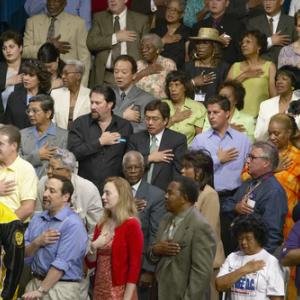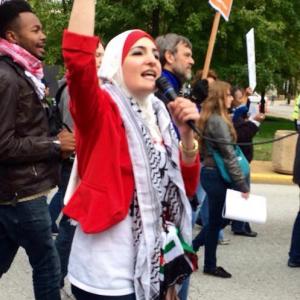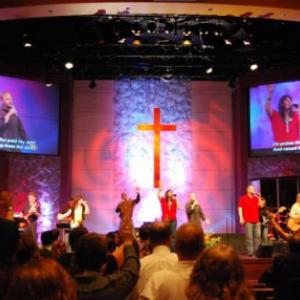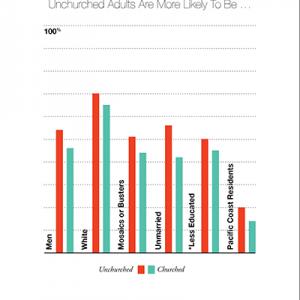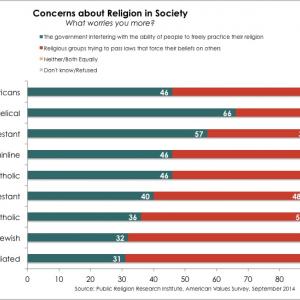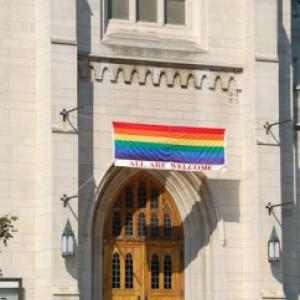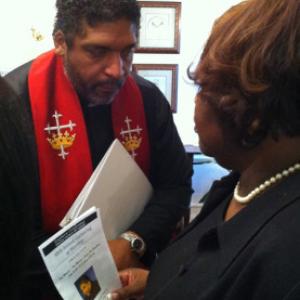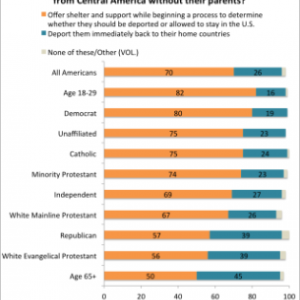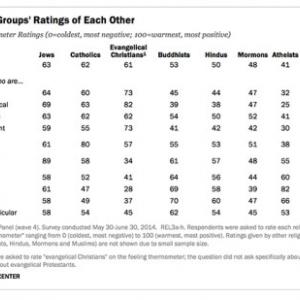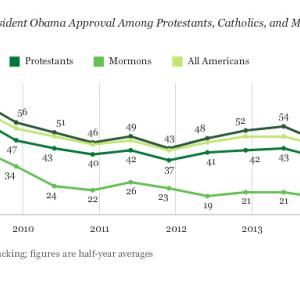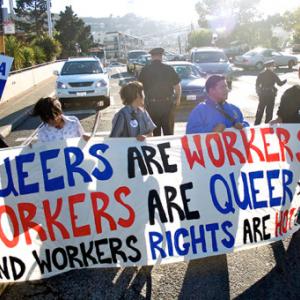Cathy Lynn Grossman is a senior national correspondent for Religion News Service, specializing in stories drawn from research and statistics on religion, spirituality, and ethics.
Posts By This Author
Why Are Religious Survey Results So Confusing?
Reading religion surveys can seem like confronting the Tower of Babel: stacked questions, confusing terms, unscientific methodology.
It gets even crazier when results are contradictory. How does that happen?
Some surveys lean like the Tower of Pisa
The Pledge of Allegiance is a perfect example.
There’s almost always a flap over how many Americans do — or don’t — want the words “under God” kicked out of the Pledge of Allegiance. Indeed, on Nov. 19 a court in Monmouth, N.J., will hear the case of the American Humanist Association battling the Matawan-Aberdeen Regional School District to have schools edit out mention of God.
The humanists claim 34 percent of Americans agree with their view. But, wait. What about a survey conducted earlier this year by LifeWay Research, a Christian research agency? It found that only 8 percent would cut God from the Pledge.
Why four times the difference? Look to the poll language.
LifeWay asked: “Should the words ‘under God’ be removed from or remain in the Pledge of Allegiance to the United States of America?” That’s a straight-up question with no preface.
The humanists’ survey, however, began with a bit of pointed Pledge history — before getting to the (loaded) question:
“For its first 62 years, the Pledge of Allegiance did not include the phrase ‘under God.’ During the Cold War, in 1954, the phrase ‘one nation, indivisible … ‘ was changed to read ‘one nation, under God, indivisible … ‘. Some people feel this phrase in our national pledge should focus on unity rather than religion.
Hashtag Activists Battle Online Anti-Muslim Speech, but #DoesItWork?
ISIS terrorist rampages, waves of anti-Muslim hate speech and fear-mongering Islamophobia are inspiring an outburst of online activism in the form of Twitter hashtags.
The question is: Does it work, especially over the long term?
An army of “clicktivists” — a mix of earnest advocates and pointed satirists — has entered the fray armed with 140-character positive, peaceful or humorous counter-messages.
Using names such as #TakeOnHate, #IStandUpBecause, and #NotInMyName, the pushback approach promotes the complexity, diversity and positive contributions of Islam and Muslims. Others, such as #MuslimApologies, offer sarcasm in service of the same message.
Yet the hashtags are often immediately co-opted by trolls spewing an opposite message. And some experts question whether clicktivist campaigns have lasting worth.
Linda Sarsour has no doubt they do. She’s a Brooklyn-based Palestinian activist in the streets and on social media and a co-creator of #TakeOnHate. The hashtag is accompanied by a resource website, launched in March by the National Network for Arab American Communities.
“The insidious thing about anti-Arab hate speech is that it seems to be acceptable, where the ‘N-word’ or anti-Semitic remarks are not taken with the same degree of outrage,” said Sarsour, who was chased down the street in September by a man who was later arrested for threatening to behead her.
Online, Offline Faith Go Hand in Hand
God bless online media. Almost half of U.S. adults (46 percent) say they saw someone sharing “something about their faith” on the Internet in the last week.
And one in five (20 percent) say they were part of the Internet spiritual action on social networking sites and apps — sharing their beliefs on Facebook, asking for prayer on Twitter, mentioning in a post that they went to church.
“The sheer number of people who have seen faith discussed online is pretty striking,” said Greg Smith, associate director of religion research for Pew Research Center.
Megachurch pastors have mega-followings online. Joel Osteen of Lakewood Church streams his Houston services online. Rick Warren of Saddleback Church has 1.8 million likes on his Facebook page. And Pope Francis has more than 4.6 million English-language followers, chiefly American, for his @Pontifex Twitter feed.
Brittany Maynard, Face of Right-to-Die Movement, Died as She Planned
Brittany Maynard, the 29-year-old suffering with an aggressive brain tumor, died Nov. 1— as she said she would.
Sean Crowley, spokesman for the non-profit advocacy organization Compassion & Choices, confirmed Maynard’s death Nov. 2.
“She died peacefully on Nov. 1 in her Portland home, surrounded by family and friends,” according to a statement from Compassion & Choices, which first publicized Maynard’s controversial plan to take control of her death.
The statement said Maynard suffered “increasingly frequent and longer seizures, severe head and neck pain, and stroke-like symptoms.” She chose to take the “aid-in-dying medication she received months ago.”
She captivated millions via social media by announcing her plan to end her life around Nov. 1 by taking a lethal prescription provided to her by a doctor under Oregon’s death-with-dignity law.
5 Things to Know About Death and Dying Debates
Brittany Maynard’s decision to die soon by a legal, lethal prescription, rather than let a brain tumor kill her, has provoked a national conversation and debate about end-of-life decisions.
In a new video, released Oct. 29, she says she feels herself getting sicker by the day. But since she still feels joy in living, she’ll postpone her day of death past the date originally announced — Nov. 1.
Maynard, 29, has inspired raging arguments about the values, even about the vocabulary, underlying the choices we make about our last days. Her goal, she still says, is to “influence this policy (on physician-assisted dying) for positive change.”
As ethicists, activists and religious voices square off, here are five things to know about death and dying.
Frank Schaefer Wins Final Reinstatement with Methodists
Seven years after officiating at the wedding of his gay son, the Rev. Frank Schaefer has been reinstated as a clergyman in the United Methodist Church.
The denomination’s top court upheld a June decision to reinstate Schaefer’s ministerial credentials after a trial court defrocked the Pennsylvania pastor last year.
Schaefer appealed and was reinstated by a vote of a regional court, the Northeastern Jurisdiction Committee on Appeals. At that time, Schaefer said, “I will not refuse ministry to anyone. I will never be silent again. I will always speak for my LGBTQ brothers and sisters.”
In the ruling released Oct. 27, the church’s top court upheld Schaefer’s appeal while acknowledging “some within the church do not support this outcome today,” according to United Methodist News Service.
Secularism Grows as More U.S. Christians Turn ‘Churchless’
If you’re dismayed that one in five Americans (20 percent) are “nones” — people who claim no particular religious identity — brace yourself.
How does 38 percent sound?
That’s what religion researcher David Kinnaman calculates when he adds “the unchurched, the never-churched and the skeptics” to the nones.
He calls his new category “churchless,” the same title Kinnaman has given his new book. By his count, roughly four in 10 people living in the continental United States are actually “post-Christian” and “essentially secular in belief and practice.”
If asked, the “churchless” would likely check the “Christian” box on a survey, even though they may not have darkened the door of a church in years.
Kinnaman, president of the California-based Barna Group, slides them into this new category based on 15 measures of identity, belief and practice in more than 23,000 interviews in 20 surveys.
The research looked at church worship attendance and participation, views about the Bible, God and Jesus, and more to see whether folks were actually tied to Christian life in a meaningful way or tied more by habit or personal history.
Museum of the Bible Aims for Timeless Name, Imagery
Museum of the Bible.
That’s it.
The name of the museum under construction in Washington, D.C., is official.
“We don’t need more to tell people who and what we are,” said the museum’s founder and funder, Steve Green.
But, as always with the Bible, nothing is ever simple.
The high-tech museum, set to open in fall 2017, is four blocks from the U.S. Capitol and three blocks from a global tourism mecca, the Air and Space Museum. The new museum will feature standing exhibits on the history and impact of the Bible as well as interactive features to bring viewers into Bible stories and characters.
Embattled Evangelicals: ‘War on Religion’ is Aimed at Us
These are anxious times for white evangelicals, according to two new surveys.
At 20 percent of U.S. adults, they are statistically neck-and-neck with the “nones” — people who claim no religious brand. “Nones” now tally up to 19 percent in the 2014 American Values Survey, said Robert Jones, CEO of the Public Religion Research Institute, which released the survey Sept. 23.
Evangelicals, said Jones, are on “the losing side of the culture wars, such as gay marriage, and they see that their share (of society) is shrinking and aging, adding to their sense of being embattled.”
“They can no longer say confidently they speak for all people of faith.”
Perhaps for that reason, white evangelicals, more than any other religious group, worry that the government will interfere with their religious liberty.
The survey asked which concerned people more: The government interfering with their ability to “freely practice their religion” or “religious groups trying to pass laws that force their beliefs on others.”
The overall answer was a tie — 46 percent of Americans overall for each viewpoint. But white evangelicals were significantly more worried about government interference (66 percent) than any other group.
Religion Loses Clout: Why Many Say That’s a Bad Thing
More Americans today say religion’s influence is losing ground just when they want it to play a stronger role in public life and politics.
A new Pew Research Center survey finds 72 percent of Americans say religion’s influence is declining in society — the highest percentage since Pew began measuring the trend in 2001, when only 52 percent held that view.
“Most people (overwhelmingly Christians) view this as a bad thing,” said Greg Smith, associate director of Pew’s Religion & Public Life Project. “That unhappiness may be behind their desire for more religion and politics.”
Growing numbers want their politicians to pray in public and for their clergy to endorse candidates from the pulpit. And nearly half of Americans say business owners with religious objections to gay marriage should to be able to refuse wedding-related services to same-sex couples.
There are three ways to look at the findings, released Sept. 22:
Many Church Choirs Are Dying. Here’s Why
James Merritt spent years as senior pastor of an Atlanta-area megachurch that featured a mighty choir.
Then he changed his tune.
At 50, he left First Baptist Church Snellville to plant a new church — 200 people in a rented space at a high school 12 miles away — focused on reaching a young generation.
There was and is no choir. And that puts Merritt’s current congregation, Cross Pointe Church, right on trend.
The newly released National Congregations Study finds church choirs are on the downbeat in white Protestant churches across the theological spectrum.
Choirs stand strong in black Protestant congregations, where 90 percent of regular attendees say there’s a choir at the main service. The same is true for three in four (76 percent) Catholic worshippers.
But among white conservative evangelicals, only 40 percent of worshippers say they hear a choir at services, down from 63 percent 14 years ago.
U.S. Churches Feel Beat of Change: More Diversity, More Drums
U.S. religious congregations are marching to their own drums now more than ever.
The National Congregations Study‘s latest look at the country’s churches, synagogues and mosques — the third wave of studies that began in 1998 — finds more congregations:
- Open their doors to gays and lesbians in active membership and in leadership.
- Show racial and ethnic diversity in the pews.
- Encourage hand-waving, amen-shouting, and dancing-in-the-aisles during worship.
- Disconnect from denominational ties doctrines and rules that might slow or block change.
The study, released Thursday (Sept. 11), draws on interviews with leaders at 1,331 nationally representative congregations and updates data from 1998 and 2006 studies. Non-Christian congregations were included in the study but there are too few for statistical analysis by topics.
Steven Sotloff’s Jewish Values Shaped a Life Seeing Godliness in Every Face
As thousands gathered Sept. 5 at Temple Beth Am in Miami to mourn journalist Steven Sotloff, they paid tribute to the one quality his family and friends tried hard to conceal from his Islamic State captors: his Jewishness.
Sotloff was not only Jewish, he held U.S.-Israel dual citizenship. But during that terrible year of his captivity, dozens of family and friends worked to scrub that detail from any public mention of the 31-year-old reporter for fear he would be persecuted for it. It appears word never got out, though he was brutally beheaded nonetheless.
In death, the Jewish values that informed his life are coming forward. One of the most moving testimonies Friday came from a childhood classmate Danielle Berrin, who writes for the Jewish Journal in Los Angeles.
Speaking to Jose Diaz-Balart on his morning MSNBC talk show, Berrin said Sotloff’s Jewish education was “one of the beautiful things” about him.
Joan Rivers: Wicked Humor with a Jewish Touch
Joan Rivers, 81, the acid-tongued survivor of popular comedy and entertainment, died Sept. 4. Who could possibly find it funny?
Joan would have.
Humor, she said, was how she dealt with all life’s triumphs and defeats.
She once said, “I knew I was funny and I knew it was powerful” as early as 8 years old.
Born Joan Alexandra Molinsky in Brooklyn, the daughter of Russian immigrant Jews, she graduated Phi Beta Kappa from Barnard. (“My mother wanted M.D. to stand for Make Dollars.”)
But she couldn’t get a door opened to the stage until she started making the gatekeepers — the agents’ secretaries — laugh.
She worked her way up through New York comedy clubs, over into TV and finally, after seven auditions, onto a stand-up stint on Johnny Carson’s “Tonight Show.” By 1983, she was Carson’s regular guest host until a bitter feud over her competing TV endeavors brought their friendship to an end.
Rivers’ first marriage ended in divorce; her second ended in tragedy when her husband killed himself. Even so, she said, “I enjoy life when things are happening. I don’t care if it’s good things or bad things. That means you’re alive.”
‘Moral Monday’ Expands to a Week of Social Justice Action Across U.S.
The Moral Monday movement, birthed by activists who protest the actions of the North Carolina General Assembly, will expand to 12 states on August 22 in a so-called Moral Week of Action.
The Rev. William J. Barber II, president of the NAACP in North Carolina and organizer of the Moral Monday movement, announced that Alabama, Arkansas, Florida, Georgia, Indiana, Mississippi, New York, Ohio, Pennsylvania , Tennessee, and Wisconsin would join up.
Each state is mobilizing social justice activists and clergy to call out governors and state legislatures for “regressive attacks” on the people Jesus called “the least of these,” Barber said in a press call on August 19. Last year, more than 1,000 people were arrested during a series of Moral Mondays in North Carolina.
The objective is to push for the politicians to “repent and reform,” he said. But the marchers will have a daily theme promoting positive actions, not only decrying current policies, he said. Each state sets its own program, but most emphasize the same issues as North Carolina. After each rally there, participants will fan out to register voters.
Losing Religion at College?
You don’t need a doctoral degree to think higher education leads people away from organized religion. That’s been common wisdom for decades.
Now, a sociologist’s new generational study upends that thinking.
Today, it’s the least-educated members of Generation X—people born roughly between 1965 and 1980—who are “most likely to leave religion,” said Philip Schwadel, an associate professor of sociology at the University of Nebraska–Lincoln.
Millennials—Americans roughly between the ages 18 and 30—were not included in the study because, Schwadel said, it’s too soon to tell if they will settle on a religious identity.
Schwadel, whose study is published in the August edition of the journal Social Forces, found a clear historical shift.
“Americans born in the late 1920s and ‘30s who graduated from college were twice as likely to drop out of religion than people who didn’t graduate from college,” he said.
The postwar baby boomers proved to be “the last holdout of the church dropouts.” For boomers, “a college degree was still associated with a higher likelihood of leaving religion.”
However, for the generation born in the 1960s, there’s no difference between those who did and those who did not go to college in their likelihood of religious affiliation. Now, for America’s middle-aged adults who were born in the 1970s, “those without a college education are the most likely to drop out.”
Survey: Most Americans Say U.S. Should Shelter, Not Deport, Child Migrants
Most Americans say the waves of children crossing into the United States from Central America are refugees fleeing danger at home. And they say the United States should support these children while reviewing their cases, not deport them immediately.
Democrats (80 percent), independents (69 percent), and Republicans (57 percent) favor offering support to unaccompanied children while a process to review their cases gets underway.
Most major religious groups say the same, including white evangelical Protestants (56 percent), white mainline Protestants (67 percent), minority Protestants (74 percent), Catholics (75 percent), and the religiously unaffiliated (75 percent).
(The survey sample of 1,026 adults was not large enough to capture the views of smaller religious groups, such as Jews, Muslims, or Mormons).
“It makes a difference that we are talking about children facing violence and harm,” said Robert P. Jones, CEO of PRRI. “The value of keeping families together cuts across all party lines.”
Americans View Jews, Christians Warmly; Atheists, Muslims Get Cold Shoulder
A new Pew Research survey finds U.S. adults feel most warmly about people who share their religion or those they know as family, friends or co-workers.
Americans give their highest scores to Jews, Catholics, and Evangelicals on a zero-to-100 “thermometer” featured in the survey, “How Americans Feel about Religious Groups,” released Wednesday. They’re nestled within a few degrees of each other: Jews, 63; Catholics, 62; evangelicals, 61.
In the middle of the chart: Buddhists, 53; Hindus, 50; Mormons, 48. Trending to the chilly negative zone: atheists at 41 and Muslims at 40.
Pew took the thermal reading because “understanding the question of how religious groups view each other is valuable in a country where religion plays an important role in public life,” said Greg Smith, Pew’s associate director of religion research.
Party Ties, Not Religious Ones, Drive Down Obama's Approval Rating
Most Christians don’t approve of President Obama right now, but he gets high ratings from Muslims and other minority religious groups.
It’s not because of their religion, though.
Obama’s level of popular approval matches Americans’ political party ties, not their religious identity, age or almost any other demographic characteristic, said Jeffrey Jones, managing editor of the Gallup poll.
The newest Gallup tracking poll shows the president’s approval rating in June averaged 43 percent for Americans overall. However, his ratings sank with Catholics to 44 percent, down from 54 percent in June 2013.
LGBT Workers May Feel Impact of Hobby Lobby Ruling
What’s the next religious liberties faceoff? Some suggest it could be between LGBT workers and religious owners of private businesses.
On Monday, while news media dissected the Supreme Court’s Hobby Lobby ruling, President Obama pledged to sign an order protecting federal employees from discrimination based on gender identity .
But he has yet to sign an executive order version of the Employment Non-Discrimination Act, which would ban discrimination based on gender identity for all federal contractors and subcontractors, an order that affects for-profit businesses.
Now, in the wake of the Hobby Lobby ruling, such an order could rile the waters again, several legal experts say. They see a line between a ruling about contraception and hiring, firing, and benefit concerns for lesbian, gay, bisexual, and transgender employees.
